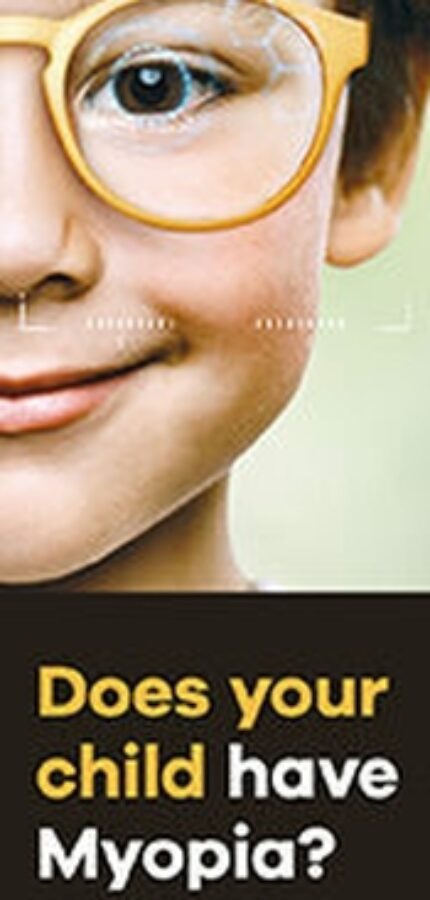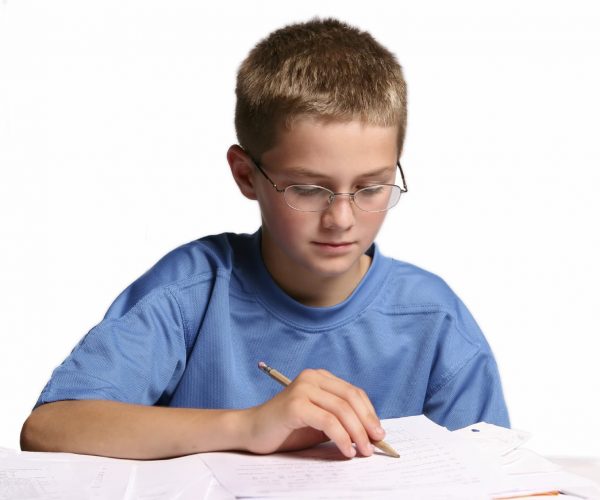Myopia Management
What is myopia?
Every parent should be aware of the signs of myopia (short-sightedness) developing in their child.
Myopia is usually easy to correct with glasses or contact lenses. However, when it occurs in young children it is very concerning as it can progress rapidly and continue to worsen until adulthood.
How do I spot the symptoms?
You may notice one or more of these signs in your child:
- needing to sit nearer the front of the class at school
- sitting closer to the television
- experiencing headaches after watching TV or other distance tasks
- holding books and devices very close
- blinking excessively or squinting
- rubbing their eyes frequently
- complaining of headaches and tired eyes
How might myopia affect my child’s eyesight in the future?
Unfortunately, a childhood diagnosis of myopia means life-long eye care and, in general, the younger the child when their myopia starts, the faster their vision will worsen and the more myopic they will become as an adult.
Adults with high levels of myopia need stronger, thicker lenses and are at increased risk of developing sight threatening conditions such as retinal detachment and myopic maculopathy.
To check your child’s risk factors click on the button below:
What treatment is available?
Whilst there is no cure for Myopia, there is a solution. Whilst existing myopia cannot be reversed, its progression can potentially be slowed down and, in some cases, halted by employing one of the Myopia Management treatment options below.
- Miyosmart spectacle lenses
Miyosmart is the latest technology, and the simplest solution, for correcting your child’s vision whilst significantly slowing the progression of their myopia, by an average of 60%3 at the same time.
Miyosmart lenses are non-invasive and worn like normal glasses. Ideal for even the most active child, they are made of lightweight impact-resistant polycarbonate with built in UV protection and anti-reflective, water repellent coating.

- Specialist soft contact lenses
These daily contact lenses are specially designed to correct existing myopia, giving clear distance and near vision, and they are also proven to slow, and even sometimes halt, the progression of myopia in children.
- Orthokeratology (Ortho-k)
Ortho-k custom made contact lenses correct your vision while you sleep giving clear, natural vision throughout the day for both adults and children. Ortho-k lenses have also been proven to slow the progression of myopia in children by 40 – 50%.5
Please contact your nearest DW Roberts’ branch for further information about our Myopia Management options.
The link below explains what EyeDream Ortho-k is and how it works.
https://www.eyedreamlenses.com/video-gallery-page
References
- Morgan, P. Is Myopia Control the Next Contact Lens Revolution? The Optician 2016.
- The College of Optometrists. Article 20.1.16 – [NICER] Study shows myopia prevalence in children in the UK has more than doubled in the last 50 years.
- Tse DY, Lam SC, Guggenheim JA, Lam C, Li KK, Liu Q, To CH. Simultaneous defoucs Integration during g refractice development.
- Paul Chamberlain et al. A 3-year Randomized Clinical Trial of MiSight Lenses for Myopia Control. Optom Vis Sci 2019;96:556–567
- The College of Optometrists. Guidance for Optometrists – Myopia Management, February 2019.
Important information
The results of myopia management intervention vary for each child and are not guaranteed. It is difficult to accurately measure the improvement as it is not known how myopic your child would have become without myopia management.
The treatments are safe and are currently some of the best available options for slowing the progression of myopia.
Myopia management treatment needs to continue until your child’s eyes have stopped growing.

SchoolVision
Help with reading
If your child (aged 5 -14) has any of the following problems:
- Has difficulty reading
- Is falling behind at school
- Complains of headaches or words jumping or moving
- Reads letters incorrectly or omits them
- Follows the text with their finger
We may be able to help with our specialist Schoolvision service. The Schoolvision assessment programme has been developed to correct early sight problems that are often not picked up in a standard sight test.
Children falling behind with their schoolwork can sometimes become frustrated. Disruptive behaviour at school can occasionally follow. Some children can be mislabelled as dyslexic or as having Attention Deficit Disorder (ADD), when visual problems could actually be the real cause of their difficulties.
When neither eye is dominant text can appear to move as the eyes compete with each other. Our Schoolvison assessments aim to help reduce these difficulties by using tints and prisms to reinforce the dominant eye and allow comfortable, stable vision for reading. The assessment can have a positive impact on your child with improved performance with their reading and schoolwork.
DW Roberts Schoolvision programme
The schoolvision programme is designed to:
- Improve your child’s reading speed and concentration
- Improve your child’s classroom behaviour / attention
- Increase your child’s self-esteem and confidence
If our initial NHS sight test has identified that the Schoolvision programme is appropriate for your child, a Schoolvision assessment can be arranged and carried out by one of our qualified Schoolvision optometrists. Regular assessments will then be carried out at 3 to 6 monthly intervals for up to 24 months. The Schoolvision assessment programme is a private service not covered by the NHS. Many of the tests carried out in the Schoolvision assessment are not included in the NHS eye examination.
If you would like to book a Schoolvision assessment or simply find out more about the service including costs please contact your nearest DW Roberts practice.
DW Roberts have been carrying out Schoolvison assessments for children with reading and learning difficulties since 2012. During that time we have helped over 800 patients mainly children but a few adults have benefitted from the service too. Most of these have significantly improved their reading speeds and reported increased self-confidence.

